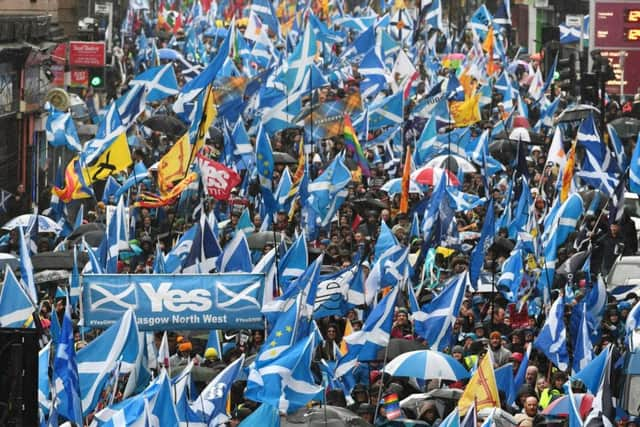Scottish independence: Are All Under One Banner marches having an effect? – Martyn McLaughlin
One of the most widely circulated photographs from the weekend’s All Under One Banner (AUOB) march was typical of the striking imagery conjured up by the movement.
Its latest mobilisation of Scottish independence supporters transformed busy Glasgow thoroughfares into mobile art installations, with tens of thousands of people brandishing Saltires.
Advertisement
Hide AdAdvertisement
Hide AdThe mass display of nationalist iconography was visually striking, although some observers were more beguiled by its power than others. “It is inconceivable that this level of support will not lead to political change,” noted Paul Monaghan, the former SNP MP, on Twitter alongside a photo of the event.


It was an observation which, in part, explained why the people of Caithness, Sutherland and Easter Ross decided it was time to be represented by someone with sharper critical faculties than the good doctor.
So too, it betrayed perhaps the most perilous enemies facing the independence cause – not Boris Johnson and Sajid Javid, but complacency and self-regard.
In Mr Monaghan’s defence, no one should deny or downplay the intoxicating experience of assembling to march. There is a rare, primal thrill to be found in surging forward en masse – a droplet in a sea of people – to champion a cherished cause. When that cause happens to be political, such demonstrations normalise the issues in play, and empower the participants.
The pace quickens. Voices grow louder – their sheer numbers confer power on the chants and songs. Or at least, that is how it seems from inside the muggy delirium of the fray.
Genial gatherings
Pierce it and gnawing questions emerge, especially when the crowd’s concern lies with Scotland’s independence.
Some questions are unresolved. Others have barely been asked at all. Chief among them is whether the marches are furthering the movement.
Whenever an AUOB march has been held of late, I cannot help but be reminded of Elvis Presley’s reply when quizzed on his global fame. “Since the beginning, it was just the same,” he mused. “The only difference, the crowds are bigger now.”
Advertisement
Hide AdAdvertisement
Hide AdSo it is with the AUOB events – genial gatherings, shot through with good humour, imaginative placards, and rousing spirits.
Take the testimony of Sandra White, the long-serving Glasgow MSP and a veteran attendee at pro-independence demonstrations. Last year, she reflected on how she met a woman from London who travelled north to march on her crutches.
The gatherings, reasoned Ms White, gave such people a “sense of purpose, pride, and likemindedness”. Which, for the folk involved, is heartening. But how does revelling in a false consensus hasten political change?
As a movement with a defined, unifying purpose – “to raise the profile of the need of an independent Scotland” – has AUOB evolved since it was inaugurated in the weeks after the 2014 referendum?
Yes, its marches have prospered in scale and frequency, but its sole indicator of success seems to be crowd sizes – a blunt measure of a protest’s effectiveness, and one which does not pass muster as a mechanism of progress.
Self-affirming thrill
Leaving aside some of the more fanciful attendance figures that have been bandied around, only the most blinkered unionist would deny there has been an upsurge in participants. But what then?
Has this valuable human resource been harnessed for direct activism? Are the flag bearers also door knockers, willing to augment the visceral, self-affirming thrill of marching with the unheralded work of canvassing? Have its messaging and speakers changed since 2017? Has it discerned shifts in tone and mood? If so, has it been able to accommodate it?
It is hard to answer any of these questions, not least because of the SNP party machine’s qualified support of AUOB. The presence of cabinet stalwarts like Humza Yousaf at its events is a seal of approval, but the fact that Nicola Sturgeon has stayed clear, instead signalling her support on social media, is telling. Senior SNP figures know that just as she cannot ignore the marches, she cannot embrace them – not when divisive figures such as Tommy Sheridan and Craig Murray are regular fixtures.
Advertisement
Hide AdAdvertisement
Hide AdAs a grassroots body, AUOB cannot – and should not – dictate who joins its marches, but it also styles itself as pressure group, and as such, it should welcome, if not initiate, a positive debate about how its supporters can play a more involved role in the SNP’s oft-mooted campaign of gentle persuasion.
Given all that has transpired in the last five years, it is easy to forget the vibrancy of the Yes campaign in the final days and weeks leading up to the referendum, and how easy it was to be deceived by its energy – seduced into mistaking the noise and visibility as signs of an irreversible shift. Perhaps that analysis will be borne out. That day has yet to come.
In the meantime, AUOB doubtless has a valuable role to play in what promises to be a protracted and demoralising campaign, yet now may be the time to explore whether its established brand of folk politics risks being perceived as a pastime instead of a force capable of constitutional transformation.
There is power in the marches and in the tens of thousands of voices speaking as one. Maybe, however, those crowds would be best served by those brave enough to turn their back on them.